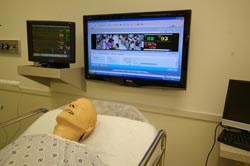- ignature AV designed and installed the AV system for the University of Minnesota's Medical School new patient simulators classrooms in the Phillips-Wangensteen building.MINNEAPOLIS, MN-The University of Minnesota Medical School graduates over 200 students a year who go on to pursue careers as doctors, nurses, and EMTs. As part of the process that transforms them from eager neophytes into competent professionals, the students practice handling a range of complicated medical scenarios using sophisticated patient simulators. The life-sized simulators have pulses, hearts, lungs, bowels, and the capacity to vocalize. They are able to present the symptoms of many medical complications, responding appropriately to students' interventions. The school has several such simulators housed in four rooms of a new facility in the basement of the Phillips-Wangensteen building on the Twin Cities campus. For the purposes of monitoring students during a simulation, and for grading and debriefing students after they have finished, the school hired Signature AV of Alexandria, VA to capture room audio, video, and simulator output to a control room, a classroom, and a companion recording system. The design centered on Symetrix' SymNet digital signal processors to provide the system's complicated routing and filtering.
- Each of the four rooms is wired with Crown ceiling-mounted microphones, and the technician running a particular simulation has the option to wire particular students or instructors with four Shure wireless lavaliere microphones. The technician runs the simulations from a master control room, and can communicate with participants via JBL speakers in each simulation room powered by a QSC paging amplifier. In addition, an adjacent classroom with QSC amplifiers and JBL speakers allows for real-time viewing or debriefing from the recording system. All of the audio coming to or from each of the simulation rooms, the control room, the classroom, and the computer recording system is processed by two SymNet 8x8 DSP units with inputs expanded by two BreakIn12 units and outputs expanded by two BreakOut12 units. The modest routing flexibility is accessible via an AMX Netlinx touchpanel interface.
In addition to audio, Signature AV's John Wormington designed and installed a comprehensive video system. Two ceiling-mounted Panasonic PTZ cameras in each simulation room capture the students' activities with adjustable aiming via the control room AMX touch panel. In addition, video output from each simulator's EKG records the patient's vitals at a glance. All three video feeds from each simulation room go the control room, the classroom, and the computer recording system.
"We went with the SymNet DSP on this project because of its proven reliability," explained Wormington. "I got into the AV business on the audio side, working with XM Radio, and have a lot of experience with SymNet's parent brand, Symetrix. They build solid gear and deliver clear audio, and their design and manufacturing philosophies are maintained in SymNet."
Signature AV's company principal JP Bonin added, "The SymNet software is also intuitive and easy to program. We were able to save the University of Minnesota a lot of money on this project by using the relatively cheap SymNet DSP filters and EQs to remove the considerable HVAC noise from the building's main duct, which runs right over the top of the simulation rooms. Mechanically isolating the rooms would have been exorbitantly expensive."
The duo also explained that schools with patient simulators face a tradeoff in their assignment of a technician to run the simulators. Because very few people have in-depth AV knowledge and in-depth medical knowledge, the choice of technician must lean in one of these two directions. Either the technician can work the nuts and bolts of the AV system with only surface knowledge of the medical situations under study, or the technician can gloss over the AV details with a deep understanding of what the students are experiencing.
"Different schools make different choices for legitimate reasons," said Wormington. "The University of Minnesota wanted technicians with significant medical knowledge. With SymNet, we were able to create a system that largely takes care of itself. SymNet's advanced automatic gain control and SPL computer algorithms remove most of the housekeeping duties of an AV technician with almost no perceptible loss of quality."










